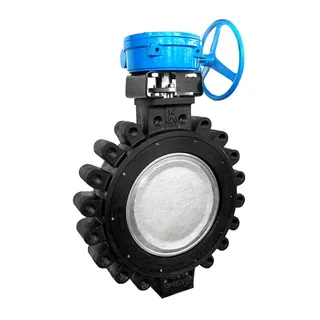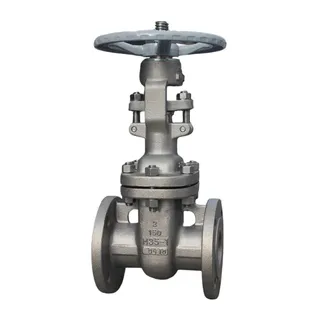In the chemical, pharmaceutical, electric power, and many other industries, pipeline systems face challenges from various corrosive media such as strong acids, strong alkalis, and organic solvents. How to effectively prevent these corrosive substances from eroding pipelines and valves has become a key issue to ensure production safety and extend equipment life. As a highly efficient corrosion-resistant solution, fluorine lined valves have become the preferred choice in many industrial fields due to their excellent performance and wide application range. This article will give a detailed introduction to the fluorine lining materials, structural features, advantages, application fields, and precautions for use of fluorine lined valves, helping you gain a comprehensive understanding of this important industrial equipment.
The main structure of fluorine lined valves includes the valve body, valve disc, and valve seat. These parts are usually made of steel or iron materials to ensure the valve's mechanical strength and pressure-bearing capacity. The inner wall or outer surface of the valve body is lined with fluoroplastic materials, and the selection of these materials depends on specific working conditions and types of media. Common lining materials include FEP (Fluorinated Ethylene Propylene), PCTFE (Polychlorotrifluoroethylene), PTFE (Polytetrafluoroethylene), and others, all of which give fluorine lined valves excellent corrosion resistance.
Fluorinated ethylene propylene is a fluoroplastic with outstanding performance, suitable for almost all organic solvents or reagents. Whether it is dilute or concentrated inorganic acids, alkalis, ketones, aromatic hydrocarbons, or chlorinated hydrocarbons, it can easily handle them. Its operating temperature range is from -85℃ to 150℃, maintaining stable performance under extremely low and high temperatures. The mechanical, electrical, and chemical stability of FEP are basically equivalent to those of PTFE, but its prominent advantages are higher impact toughness and excellent weather and radiation resistance. This means that in complex industrial environments, FEP lining can better resist external factors and extend the valve's service life.
The corrosion resistance of polychlorotrifluoroethylene ranks only second to PTFE. It can adapt to various organic solvents and inorganic corrosive liquids, including oxidizing acids. Its operating temperature range is from -195℃ to 120℃, giving it unique advantages in low-temperature applications. The heat resistance, electrical properties, and chemical stability of PCTFE are excellent, while its mechanical strength, creep resistance, and hardness are slightly better than PTFE. This allows PCTFE-lined valves to maintain better stability and reliability under high-strength and high-pressure conditions.
Polypropylene is a lightweight plastic suitable for aqueous solutions of inorganic salts, dilute or concentrated inorganic acids, and alkalis. Its operating temperature range is from -14℃ to 80℃, and it has good corrosion resistance under normal temperature conditions. The advantages of polypropylene are that its yield, tensile, and compressive strength and hardness are better than those of low-pressure polyethylene, featuring outstanding rigidity and heat resistance. In addition, polypropylene is easy to form and has low cost. After modification, its impact strength, fluidity, and flexural elasticity can be further improved, making it highly cost-effective in some cost-sensitive applications.
Rigid polyvinyl chloride material is suitable for various media, including water, concentrated alkalis, non-oxidizing acids, aliphatic hydrocarbons, oils, and ozone. Its operating temperature range is from 0℃ to 55℃, and it has good chemical stability and corrosion resistance at normal temperatures. PVC has high mechanical strength, excellent chemical stability and dielectric properties, and good oil resistance and aging resistance. Moreover, PVC is easy to weld and bond, convenient to process, and relatively low in price, making it widely used in applications with cost and processing requirements.
Polytetrafluoroethylene is the most well-known fluoroplastic, famous for its outstanding chemical stability and corrosion resistance. It can resist the erosion of various extreme chemical media, including strong acids, strong alkalis, and strong oxidizing agents. Its operating temperature range is wide, from -200℃ to 180℃. PTFE has an extremely low friction coefficient and is an excellent self-lubricating material, making it outstanding in applications requiring low friction. However, PTFE has relatively low mechanical properties, poor fluidity, and large thermal expansion, which limit its application to some extent. Nevertheless, PTFE remains an indispensable material in many industrial fields, especially in occasions requiring high corrosion resistance and self-lubricating performance.
Polyvinylidene fluoride has excellent resistance to chemicals and solvents and can adapt to most chemical media. Its operating temperature range is from -70℃ to 100℃, performing excellently in low and normal temperatures. The tensile and compressive strength of PVDF are better than PTFE, and it has good bending, weather, and radiation resistance. Its main feature is good toughness and easy formability, making PVDF-lined valves advantageous in applications that require high toughness and complex shapes.
Before understanding the wide application of fluorine lined valves, let us first discuss the unique advantages that make them stand out in many industrial fields and become the ideal choice for handling corrosive media.
The greatest advantage of fluorine lined valves lies in their outstanding corrosion resistance. Fluoroplastic materials can resist various strong acids, strong alkalis, organic solvents, and strong oxidants, suitable for almost all corrosive media. Whether sulfuric acid, hydrochloric acid, hydrofluoric acid, aqua regia, or other organic acids and strong oxidants, fluorine lined valves can maintain stable performance within the temperature range of -50℃ to 150℃, effectively preventing corrosion of the medium to the valve.
Due to their excellent corrosion resistance, fluorine lined valves are widely used in petroleum, chemical, dyeing, pharmaceutical, electric power, and environmental protection industries. In situations dealing with corrosive or high-temperature media, fluorine lined valves perform excellently, effectively ensuring the safety and stability of production processes. For example, in the chemical industry, fluorine lined valves are often used to transport and control various corrosive chemicals; in the pharmaceutical industry, they are used to handle media with high sanitary requirements, ensuring the quality and safety of pharmaceutical production.
Fluorine lined valves are manufactured by molding, with the lining material tightly bonded to the valve body to form good sealing performance. This design not only improves the sealing performance of the valve but also effectively prevents fluid leakage. In some applications with extremely high sealing requirements, fluorine lined valves can reliably prevent medium leakage and ensure the safety of the production environment.
The smooth surface of fluoroplastics is not prone to dirt adhesion, making fluorine lined valves very easy to clean. This is especially important in industries such as food and pharmaceuticals, where hygiene requirements are high. In addition, fluoroplastics are excellent electrical insulation materials, suitable for applications in the electrical industry, effectively preventing current leakage and interference.
Compared with corrosion-resistant metal materials, fluorine lined valves are more cost-effective. Although the manufacturing process is relatively complex, in many cases they can provide corrosion resistance comparable to metal valves. This gives fluorine lined valves a significant advantage in terms of cost performance, especially in cost-sensitive applications, where they can meet high corrosion resistance requirements at a lower cost.
Although fluorine lined valves have many advantages, there are also several precautions that must be observed during use to ensure their performance and service life.
The applicable temperature range of fluorine lined valves is generally between -50℃ and 150℃. Beyond this range, the performance of the fluorine lining material may be affected, leading to valve failure. Therefore, during use, it is necessary to strictly control the medium temperature to avoid exceeding the applicable temperature range of the valve.
The installation and operation of fluorine lined valves require special attention. During installation, it is essential to ensure the sealing performance of the valve to prevent leakage caused by improper installation. During operation, replacing packing under pressure must be avoided, as this may cause medium leakage. In addition, the lining material of fluorine lined valves has high performance requirements, so high-quality fluoroplastic materials must be selected to ensure corrosion resistance and service life.
Although fluorine lined valves have excellent corrosion resistance, they are not suitable for all media. For example, they are not suitable for media containing solid particles, as these particles may scratch the lining material, causing valve failure. When selecting fluorine lined valves, the type of medium and working conditions must be carefully considered to ensure valve performance and longevity.
Regular maintenance and inspection are key to ensuring the normal operation of fluorine lined valves. During use, the sealing performance, wear condition of the lining material, and mechanical properties of the valve should be checked regularly. Timely detection and resolution of potential problems can effectively extend the service life of the valve and ensure production safety and stability.
As an efficient corrosion-resistant solution, fluorine lined valves have been widely used in chemical, pharmaceutical, electric power, and environmental protection industries. Their excellent corrosion resistance, good sealing performance, easy cleaning and maintenance, and high cost-effectiveness make them the preferred choice in many industrial applications. However, during use, attention must be paid to temperature limits, installation and operation, medium compatibility, and maintenance and inspection to ensure performance and service life. With the continuous development of industrial technology, fluorine lined valves will continue to play an important role in handling corrosive media, providing strong protection for the stability and safety of industrial production.



